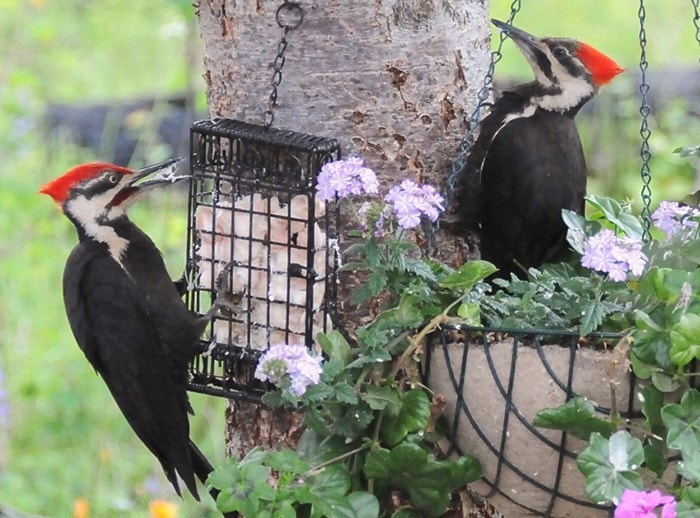Winter is a good time to concentrate on sounds of birds other than the calls and songs of spring and summer made by robins, warblers, song sparrows and buntings, to list a few. Now seemingly dominating the winter season are the calls of ravens, crows, Steller’s jays and pileated woodpeckers, whose loud “kak, kak, kak, kak” rings through the winter forest.
Detecting the location of a pileated woodpecker is not as challenging when it is calling as when it is just “chopping” at some tree. Now, when one is located, it is even more challenging to get close enough to this sometimes not-so-shy bird to find that there is a difference between some individuals. While on a winter walk, I chanced to get a close look of a pileated chopping away on a tree below my location. In the bright afternoon sun, I got a good view of its glistening red crest and the red “moustache” streaking back from the beak, a distinguishing mark of a male pileated woodpecker.
The most common indication of the presence of woodpeckers, when winter’s chill permeates the forest, is the sound of their persistent pecking on the trunks of trees. That is how I have located most woodpeckers. However, determining the precise location may not be so easy, either. Once I heard the sound of pecking coming from some treetops. Unable to determine which tree it was, I put my ear to the trunks of several trees until I could clearly hear the pecking sound, loud and clear, through a specific trunk. It was then I knew which was its choice lunch stop.
Actually, I think some woodpeckers lunch all day long, cloudy or sunny. It doesn’t seem to matter. Late one winter afternoon, I was on the edge of a dense stand of evergreen trees where I heard a pecking sound that I had heard there before. I tried to get a good view of the bird, which I expected was a northern three-toed woodpecker. It was on the right kind of tree, had the right pecking habit and was pecking where I had heard it before. But, here it was pecking away into the dusk till it got too dark for me to possibly identify it.
Not too many of us “listen for lunch”, but woodpeckers do. They will perch on a tree trunk, cock their head one way and then the other until they get a bearing on where to drill. The sounds of wood-boring beetle larvae carving their wooden tunnels just under the bark can, at least to a woodpecker, be quite audible. Once on a summer day I was snooping some woods when I heard a barely audible scraping sound coming from a tree trunk. I was able to pinpoint the location of the sound, whereupon I put my ear to the trunk and heard it even more clearly. I am sure woodpecker hearing and smelling ability is much more acute than mine.
Tracking down a three-toed woodpecker is probably the most difficult, not because they are that quiet but because they are probably the least common of all our Kootenay woodpeckers. Along with that would be our black-backed woodpeckers. I sometimes call the three-toed a “ladder-backed” woodpecker because of the horizontal black stripes on the back between the black wings. However, ladder-backed is officially applied only to a woodpecker of agave communities of the southwestern United States. Our male three-toed and black-backed woodpeckers both have yellow crowns winter and summer. Last week the best view of a three-toed this season came, in spite of crunchy snow, on a trail in the Arrow Creek district. This male was foraging on the lower trunk of a larch giving plain views of each side, the back and of the yellow crown.
Our two common woodpeckers are the hairy and the smaller downy woodpeckers. The hairy is nearly robin size and the downy is about half that, but when they are hard to distinguish that way, then, perhaps, they can be distinguished by the bill length compared to the head. The bill of the hairy is over half the length of its head and the bill of the downy is less than half the length of its head. Both males have a little red topknot.
This winter I have seen more hairy woodpeckers in pairs than individually. A pair is coming to my beef fat feeders. They, along with pileated woodpeckers, may be seen just about anywhere there are trees or even hydro poles. The northern three-toed and black-backed woodpeckers favour dense forests of cedar-hemlock that include western larch.
Checking out our winter woodpeckers can make out door walks and exercise more interesting. Have fun!
Ed McMackin is a biologist by profession but a naturalist and hiker by nature. He can be reached at 250-866-5747.
